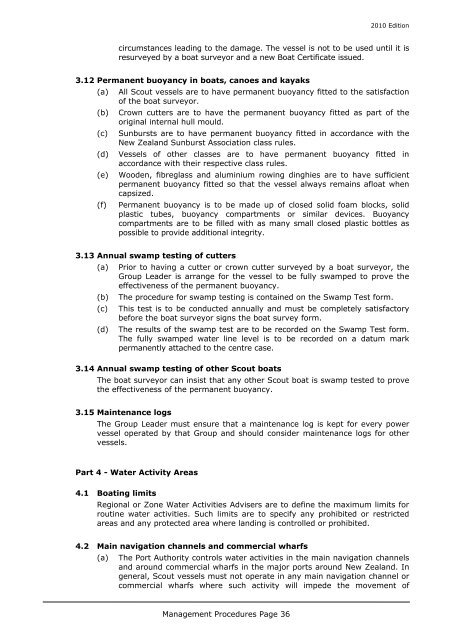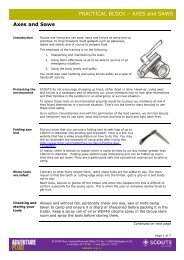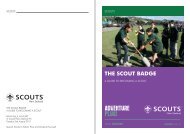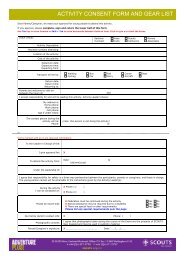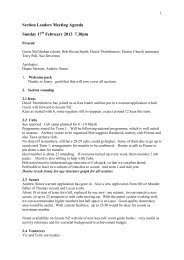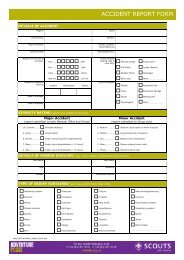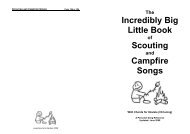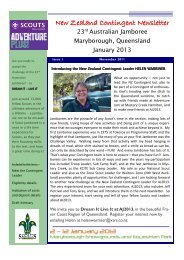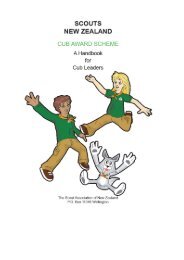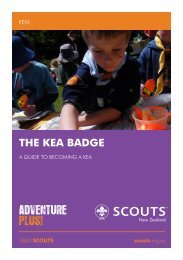The_Rule_Book - Brooklyn Scouts, Wellington
The_Rule_Book - Brooklyn Scouts, Wellington
The_Rule_Book - Brooklyn Scouts, Wellington
Create successful ePaper yourself
Turn your PDF publications into a flip-book with our unique Google optimized e-Paper software.
2010 Edition<br />
circumstances leading to the damage. <strong>The</strong> vessel is not to be used until it is<br />
resurveyed by a boat surveyor and a new Boat Certificate issued.<br />
3.12 Permanent buoyancy in boats, canoes and kayaks<br />
(a) All Scout vessels are to have permanent buoyancy fitted to the satisfaction<br />
of the boat surveyor.<br />
(b) Crown cutters are to have the permanent buoyancy fitted as part of the<br />
original internal hull mould.<br />
(c) Sunbursts are to have permanent buoyancy fitted in accordance with the<br />
New Zealand Sunburst Association class rules.<br />
(d) Vessels of other classes are to have permanent buoyancy fitted in<br />
accordance with their respective class rules.<br />
(e) Wooden, fibreglass and aluminium rowing dinghies are to have sufficient<br />
permanent buoyancy fitted so that the vessel always remains afloat when<br />
capsized.<br />
(f) Permanent buoyancy is to be made up of closed solid foam blocks, solid<br />
plastic tubes, buoyancy compartments or similar devices. Buoyancy<br />
compartments are to be filled with as many small closed plastic bottles as<br />
possible to provide additional integrity.<br />
3.13 Annual swamp testing of cutters<br />
(a) Prior to having a cutter or crown cutter surveyed by a boat surveyor, the<br />
Group Leader is arrange for the vessel to be fully swamped to prove the<br />
effectiveness of the permanent buoyancy.<br />
(b) <strong>The</strong> procedure for swamp testing is contained on the Swamp Test form.<br />
(c) This test is to be conducted annually and must be completely satisfactory<br />
before the boat surveyor signs the boat survey form.<br />
(d) <strong>The</strong> results of the swamp test are to be recorded on the Swamp Test form.<br />
<strong>The</strong> fully swamped water line level is to be recorded on a datum mark<br />
permanently attached to the centre case.<br />
3.14 Annual swamp testing of other Scout boats<br />
<strong>The</strong> boat surveyor can insist that any other Scout boat is swamp tested to prove<br />
the effectiveness of the permanent buoyancy.<br />
3.15 Maintenance logs<br />
<strong>The</strong> Group Leader must ensure that a maintenance log is kept for every power<br />
vessel operated by that Group and should consider maintenance logs for other<br />
vessels.<br />
Part 4 - Water Activity Areas<br />
4.1 Boating limits<br />
Regional or Zone Water Activities Advisers are to define the maximum limits for<br />
routine water activities. Such limits are to specify any prohibited or restricted<br />
areas and any protected area where landing is controlled or prohibited.<br />
4.2 Main navigation channels and commercial wharfs<br />
(a) <strong>The</strong> Port Authority controls water activities in the main navigation channels<br />
and around commercial wharfs in the major ports around New Zealand. In<br />
general, Scout vessels must not operate in any main navigation channel or<br />
commercial wharfs where such activity will impede the movement of<br />
Management Procedures Page 36


